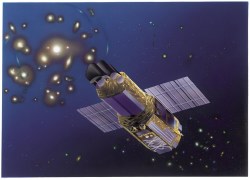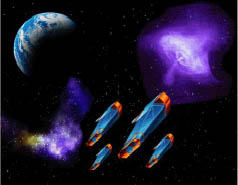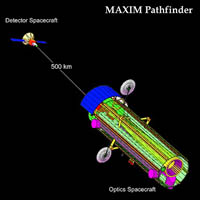The History of X-ray Astronomy:
Forty Years from Today
From 1962 to 2002, X-ray detectors improved 100 millionfold. Yet scientists are just getting warmed up. NASA's goal for the coming decades is to continue to improve X-ray resolution by a factor of a million, to attain resolution sharp enough to image a black hole event horizon.
This will be a step-by-step process. A series of missions are being planned to transport us -- virtually, through the power of resolution -- closer and closer to a black hole. Along the way we may uncover many secrets of the universe, such as the nature of dark matter and the overall structure of the cosmos.

(Credit ISAS)
Astro-E2 will be the next dedicated X-ray mission to fly, with a launch set for 2005. This Japanese-U.S. satellite, a follow-up to ASCA (Astro-D), will carry a novel detector called an X-ray calorimeter that measures the heat generated by a single X-ray photon hitting the detector. The improved sensitivity that this technology affords will allow scientists to study black holes with greater scrutiny, for the detector will provide detailed spectra of the iron gas very close to a black hole event horizon.
Astro-E2 will also detect the least abundant of elements in star explosions and in gas glowing free and hot between stars and galaxies, such as calcium, nitrogen, neon, and nickel. This will allow scientists to more accurately determine the chemical composition of the universe as well as the rate of star formation, because stars (and subsequent star explosions) generate all elements heavier than hydrogen and helium.

The Constellation X-ray Observatory, proposed for a 2008 launch, builds upon Astro-E2 detector technology as well as new X-ray imaging technology now being perfected on a high-altitude balloon experiment called InFocus. Constellation-X comprises four separate satellites, orbiting and observing X-ray sources in unison to provide the collecting power of one massive telescope.
Constellation-X will have a sensitivity 100 times greater than any past or current X-ray satellite mission. Scientists will be able to collect more data in an hour than they would have collected in days or weeks with current X-ray telescopes. Constellation-X's large collecting area also allows scientists to study thousands of faint X-ray emitting sources, not just the bright sources available to us today.
Turned towards a black hole, Constellation-X will observe accretion disks with such resolution that scientists will be able to track the fate of gas circling the black hole, noting changes in its "broad iron line" spectral emission. Currently, scientists can only calculate an average of all the X-ray flares around a black hole; the broad iron line is a composite of many flares over the course of many hours or days. Constellation-X can quickly garner useful information from just one flaring event.
Constellation-X will be able to collect enough data from a single flare to test the math of General Relativity, that is, measure changes in the broadening of the iron line as a result of its changing distance to the black hole during the length of the flare. This four-satellite observatory will also measure the mass and spin of black holes, two key measurements that, as of today, are difficult to obtain.
Turning towards the deep universe, Constellation-X will measure the mass motion of gas in the core of galaxy clusters and in the "interaction region" of possibly merging galaxies. This will test theories of cluster mergers and cluster evolution, a basis for understanding all structure in the universe. Understanding galaxy clusters is analogous to understanding how an entire forest works, not just a few trees.
Tracing the flow of hot gas also serves as an indirect measure of dark matter, the mysterious "non-visible" matter that comprises most of the mass in the universe. Ordinary matter is attracted to the gravitational potential of dark matter; thus Constellation-X can provide a map of dark matter regions.
Following Constellation-X will be observatories surveying higher-energy X rays, the type of photons that can penetrate through the dust that enshrouds supermassive black holes, star explosions and sites of nucleosynthesis. A follow-up to the Rossi Explorer, which could piggyback on Constellation-X or later missions, could provide more precise timing of the X-ray flickering characteristics of neutron stars and black holes. This would reveal fainter features in the quasi-periodic oscillations, which may be a signature of General Relativity.
MAXIM, the Micro Arcsecond X-ray Imaging Mission, is a bold endeavor to image a black hole event horizon with resolution "muscle" one million times greater than the Hubble Space Telescope or the Chandra X-ray Observatory. A direct image of gravity at its extreme will be of fundamental importance to physics, a landmark observation.
MAXIM's unsurpassed resolution -- equivalent to resolving a feature the size of a dinner plate on the surface of the Sun -- would yield untold discoveries and tremendously improve our understanding of a multitude of cosmic sources. Whereas Constellation-X entails four satellites, MAXIM may require more than 32 components orbiting in precise unison, employing a technology now being tested called X-ray interferometry. This is a challenge indeed yet within our reach.
The MAXIM Pathfinder, which would proceed MAXIM, could test this visionary technology as well as carry out important scientific objectives. The Pathfinder would contain all the X-ray interferometer parts on two spacecraft and would be about 10,000 times more sensitive than Chandra. That's a fine leap forward. This level of resolution would bring us ever closer to the disks and jets associated with black holes, as well as yield discoveries (as Chandra is yielding today) that will surely astound us.
A primary goal for X-ray astronomy in coming years is to test general relativity, Einstein's theory of gravity, and ultimately move "beyond Einstein" -- that is, find a more complete and unified theory of all the forces of nature. To reach our goal, we must journey to the limits of space, energy, gravity and time -- regions and events in space such as a black hole or the big bang where such extreme phenomenon present the ultimate physics lessons.
This journey is not unlike our quest to place a man on the moon, and X-ray astronomers invite you to join in an endeavor that very well may change the face of science and technology.
40th Anniversary Articles
- Introduction
- The Rough and Tumble Early Days
- Moving Toward the Modern Era
- The X-ray Universe Today
- Forty Years from Today



